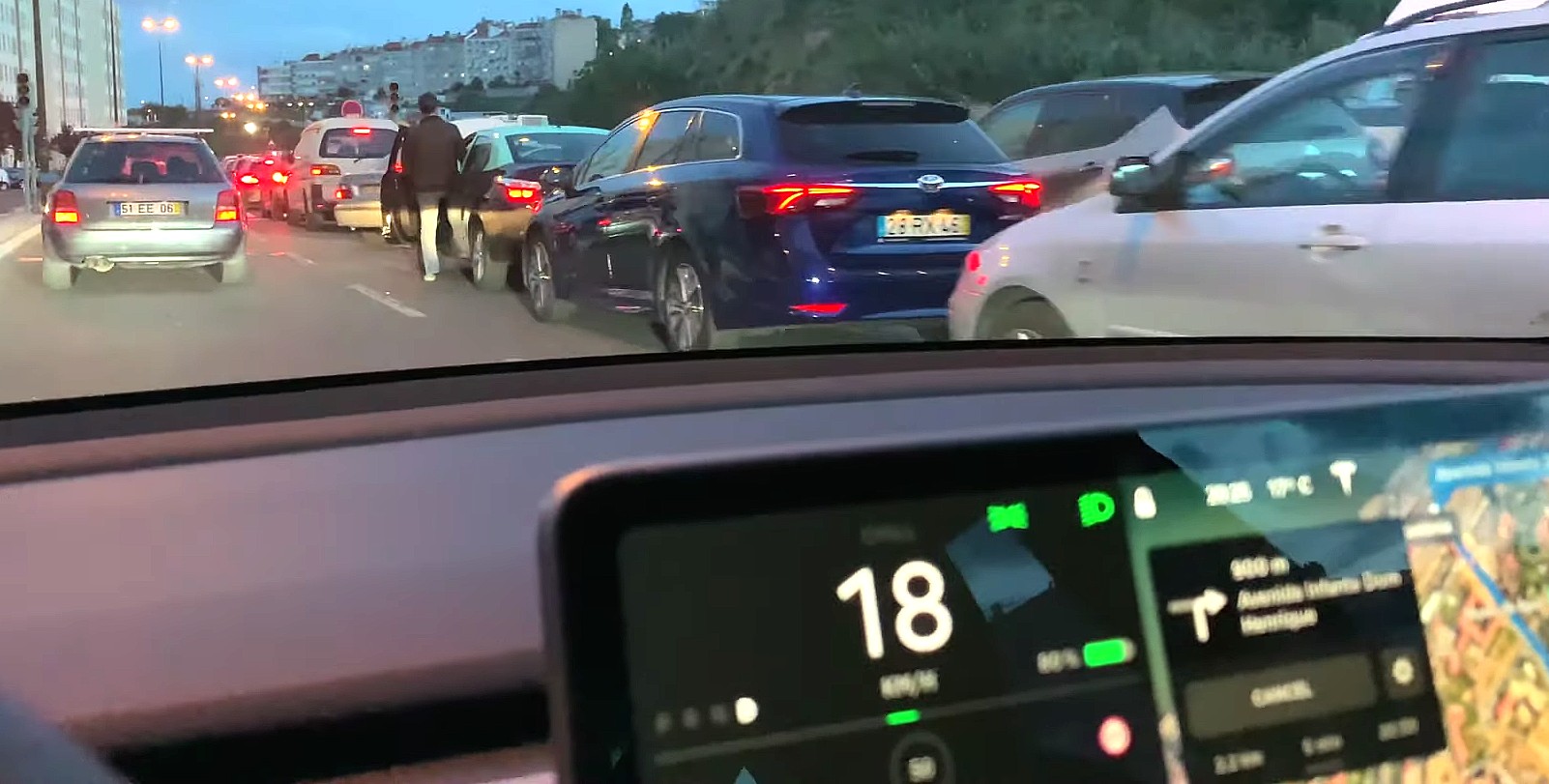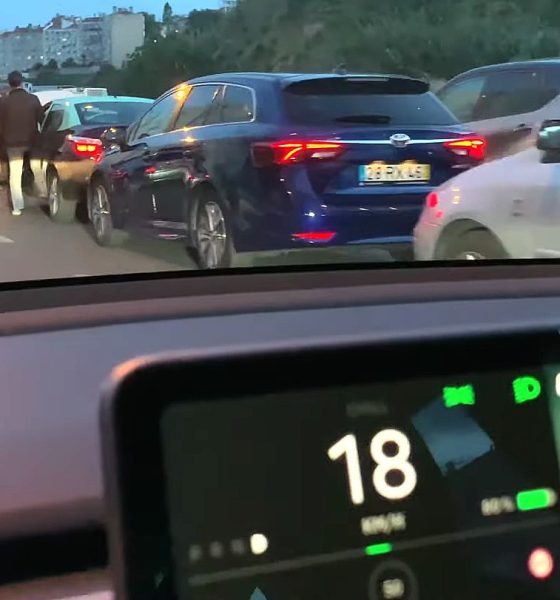

News
Tesla owners in Portugal escape fuel shortage hell due to truck drivers’ strike
Tesla owners in Portugal are thanking the electric car maker since their vehicles are proving immune to the ongoing gas crisis in the country, which resulted from a strike by fuel-truck drivers calling for higher pay and shorter working hours.
The gas shortage in Portugal got notably worse on Wednesday, the second day of the truck drivers’ strike. Hundreds of gasoline stations closed during the day, as evidenced by incredibly long lines of internal combustion vehicles lining up on stations that still had fuel. Authorities declared a national energy crisis as well, ordering truck drivers to resume deliveries to airports, hospitals, and other essential services.
The government has mandated that a “minimal” supply of at least 40% of normal gas levels must be maintained at gas stations in Lisbon and the second city of Porto. With the national energy crisis in effect, emergency vehicles such as ambulances and firetrucks are given priority to access this “minimal” supply of gas. This means that for thousands of motorists, their vehicles are severely fuel-constrained.
Amidst the chaos brought about by the ongoing truck drivers’ strike, owners of Tesla’s electric cars were able to largely avoid feeling the brunt of the fuel crisis. A Tesla Model 3 owner from the area shared a short clip from his drive home, and it showed the electric sedan passing dozens of vehicles forming a long line to a gas station.
If the truck drivers’ strike in Portugal continues, it is not only the private transport sector that will be affected. As noted in a Politico EU report, some motorists are already spending the night just to line up for fuel, and public transport operators in Lisbon and Porto have warned that buses only had a few days’ worth of fuel left. In a statement to the publication, António Medeiros, a truck drivers’ union treasurer, noted that “If we stop for two or three days, we throw Portugal into chaos. We are perfectly aware of that.”
Unfortunately, there are signs that the truck drivers’ strike would continue. A meeting between employers and the truckers’ trade union broke up without an agreement being reached on Tuesday. The strike is also seeing little political support, with Rui Rio, the leader of Portugal’s Social Democratic Party, noting that “I’m not going to attack the government over something that isn’t the government’s responsibility.”
While Tesla owners who charge their vehicles from the grid will likely experience the effects of the truck drivers’ strike if it continues, those whose homes are equipped with solar panels and battery storage units will largely be immune to further fuel shortages in the country. This independence from the grid is something that is key to Elon Musk’s plan for Tesla, which involves zero-emissions vehicles running on solar energy.
The ongoing experience of Tesla owners in Portugal all but highlights the need for the company to ramp the production of its energy business. Tesla has mostly focused on its electric car business in recent years due to the Model 3 ramp, but Musk has noted that 2019 will see Tesla ramping its energy products. Musk emphasized this point in the Model Y unveiling, stating that 2019 will be the “year of the Solar Roof.” A production ramp of the Tesla Powerwall 2 home battery storage unit is expected this year as well.

News
Tesla FSD fleet is nearing 7 billion total miles, including 2.5 billion city miles
As can be seen on Tesla’s official FSD webpage, vehicles equipped with the system have now navigated over 6.99 billion miles.

Tesla’s Full Self-Driving (Supervised) fleet is closing in on almost 7 billion total miles driven, as per data posted by the company on its official FSD webpage.
These figures hint at the massive scale of data fueling Tesla’s rapid FSD improvements, which have been quite notable as of late.
FSD mileage milestones
As can be seen on Tesla’s official FSD webpage, vehicles equipped with the system have now navigated over 6.99 billion miles. Tesla owner and avid FSD tester Whole Mars Catalog also shared a screenshot indicating that from the nearly 7 billion miles traveled by the FSD fleet, more than 2.5 billion miles were driven inside cities.
City miles are particularly valuable for complex urban scenarios like unprotected turns, pedestrian interactions, and traffic lights. This is also the difference-maker for FSD, as only complex solutions, such as Waymo’s self-driving taxis, operate similarly on inner-city streets. And even then, incidents such as the San Francisco blackouts have proven challenging for sensor-rich vehicles like Waymos.
Tesla’s data edge
Tesla has a number of advantages in the autonomous vehicle sector, one of which is the size of its fleet and the number of vehicles training FSD on real-world roads. Tesla’s nearly 7 billion FSD miles then allow the company to roll out updates that make its vehicles behave like they are being driven by experienced drivers, even if they are operating on their own.
So notable are Tesla’s improvements to FSD that NVIDIA Director of Robotics Jim Fan, after experiencing FSD v14, noted that the system is the first AI that passes what he described as a “Physical Turing Test.”
“Despite knowing exactly how robot learning works, I still find it magical watching the steering wheel turn by itself. First it feels surreal, next it becomes routine. Then, like the smartphone, taking it away actively hurts. This is how humanity gets rewired and glued to god-like technologies,” Fan wrote in a post on X.
News
Tesla starts showing how FSD will change lives in Europe
Local officials tested the system on narrow country roads and were impressed by FSD’s smooth, human-like driving, with some calling the service a game-changer for everyday life in areas that are far from urban centers.

Tesla has launched Europe’s first public shuttle service using Full Self-Driving (Supervised) in the rural Eifelkreis Bitburg-Prüm region of Germany, demonstrating how the technology can restore independence and mobility for people who struggle with limited transport options.
Local officials tested the system on narrow country roads and were impressed by FSD’s smooth, human-like driving, with some calling the service a game-changer for everyday life in areas that are far from urban centers.
Officials see real impact on rural residents
Arzfeld Mayor Johannes Kuhl and District Administrator Andreas Kruppert personally tested the Tesla shuttle service. This allowed them to see just how well FSD navigated winding lanes and rural roads confidently. Kruppert said, “Autonomous driving sounds like science fiction to many, but we simply see here that it works totally well in rural regions too.” Kuhl, for his part, also noted that FSD “feels like a very experienced driver.”
The pilot complements the area’s “Citizen Bus” program, which provides on-demand rides for elderly residents who can no longer drive themselves. Tesla Europe shared a video of a demonstration of the service, highlighting how FSD gives people their freedom back, even in places where public transport is not as prevalent.
What the Ministry for Economic Affairs and Transport says
Rhineland-Palatinate’s Minister Daniela Schmitt supported the project, praising the collaboration that made this “first of its kind in Europe” possible. As per the ministry, the rural rollout for the service shows FSD’s potential beyond major cities, and it delivers tangible benefits like grocery runs, doctor visits, and social connections for isolated residents.
“Reliable and flexible mobility is especially vital in rural areas. With the launch of a shuttle service using self-driving vehicles (FSD supervised) by Tesla in the Eifelkreis Bitburg-Prüm, an innovative pilot project is now getting underway that complements local community bus services. It is the first project of its kind in Europe.
“The result is a real gain for rural mobility: greater accessibility, more flexibility and tangible benefits for everyday life. A strong signal for innovation, cooperation and future-oriented mobility beyond urban centers,” the ministry wrote in a LinkedIn post.
News
Tesla China quietly posts Robotaxi-related job listing
Tesla China is currently seeking a Low Voltage Electrical Engineer to work on circuit board design for the company’s autonomous vehicles.

Tesla has posted a new job listing in Shanghai explicitly tied to its Robotaxi program, fueling speculation that the company is preparing to launch its dedicated autonomous ride-hailing service in China.
As noted in the listing, Tesla China is currently seeking a Low Voltage Electrical Engineer to work on circuit board design for the company’s autonomous vehicles.
Robotaxi-specific role
The listing, which was shared on social media platform X by industry watcher @tslaming, suggested that Tesla China is looking to fill the role urgently. The job listing itself specifically mentions that the person hired for the role will be working on the Low Voltage Hardware team, which would design the circuit boards that would serve as the nervous system of the Robotaxi.
Key tasks for the role, as indicated in the job listing, include collaboration with PCB layout, firmware, mechanical, program management, and validation teams, among other responsibilities. The role is based in Shanghai.
China Robotaxi launch
China represents a massive potential market for robotaxis, with its dense urban centers and supportive policies in select cities. Tesla has limited permission to roll out FSD in the country, though despite this, its vehicles have been hailed as among the best in the market when it comes to autonomous features. So far, at least, it appears that China supports Tesla’s FSD and Robotaxi rollout.
This was hinted at in November, when Tesla brought the Cybercab to the 8th China International Import Expo (CIIE) in Shanghai, marking the first time that the autonomous two-seater was brought to the Asia-Pacific region. The vehicle, despite not having a release date in China, received a significant amount of interest among the event’s attendees.








